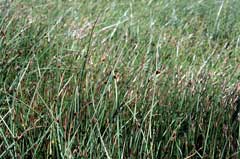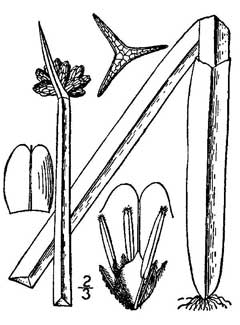 |
|
www.fws.gov |
 |
| USDA-NRCS PLANTS Database / Britton, N.L., and A. Brown. 1913. An illustrated flora of the northern United States, Canada and the British Possessions. 3 vols. Charles Scribner's Sons, New York. Vol. 1 |
Translate this page:
Summary
Physical Characteristics

 Scirpus americanus is a PERENNIAL growing to 0.6 m (2ft). It is in flower from June to July, and the seeds ripen from August to September. The species is hermaphrodite (has both male and female organs) and is pollinated by Wind.
Scirpus americanus is a PERENNIAL growing to 0.6 m (2ft). It is in flower from June to July, and the seeds ripen from August to September. The species is hermaphrodite (has both male and female organs) and is pollinated by Wind.
Suitable for: light (sandy), medium (loamy) and heavy (clay) soils. Suitable pH: mildly acid, neutral and basic (mildly alkaline) soils. It can grow in semi-shade (light woodland) or no shade. It prefers moist or wet soil and can grow in water. The plant can tolerate maritime exposure.
UK Hardiness Map
US Hardiness Map
Synonyms
S. pungens. Vahl.
Plant Habitats
Pond; Bog Garden;
Edible Uses
Edible Parts: Pollen Root Seed Stem
Edible Uses:
Root - raw or cooked[172, 257]. Rich in starch. Stem. Peeled and eaten raw or cooked[172]. Stem base - raw or cooked[172]. Pollen[172]. Rich in protein, it can be added to flour when making bread, cakes etc. Seed - cooked. A nutty flavour[172]. The seed can be ground into a powder, mixed with water, boiled and eaten as a mush[257]. The seed is rather small and fiddly to harvest and utilize.
References More on Edible Uses
Medicinal Uses
Plants For A Future can not take any responsibility for any adverse effects from the use of plants. Always seek advice from a professional before using a plant medicinally.
None known
References More on Medicinal Uses
The Bookshop: Edible Plant Books
Our Latest books on Perennial Plants For Food Forests and Permaculture Gardens in paperback or digital formats.

Edible Tropical Plants
Food Forest Plants for Hotter Conditions: 250+ Plants For Tropical Food Forests & Permaculture Gardens.
More

Edible Temperate Plants
Plants for Your Food Forest: 500 Plants for Temperate Food Forests & Permaculture Gardens.
More

More Books
PFAF have eight books available in paperback and digital formats. Browse the shop for more information.
Shop Now
Other Uses
Basketry Hair Weaving
The leaves, mixed with oil, have been rubbed on a child's head to make the hair grow long and thick[257]. The leaves have been used in making baskets and shopping bags[257]. They have also been woven into hats[257].
Special Uses
References More on Other Uses
Cultivation details
Succeeds in any wet to moisture retentive ground, pond margins and shallow water in full sun or shade[200].
References Carbon Farming Information and Carbon Sequestration Information
Temperature Converter
Type a value in the Celsius field to convert the value to Fahrenheit:
Fahrenheit:
The PFAF Bookshop
Plants For A Future have a number of books available in paperback and digital form. Book titles include Edible Plants, Edible Perennials, Edible Trees,Edible Shrubs, Woodland Gardening, and Temperate Food Forest Plants. Our new book is Food Forest Plants For Hotter Conditions (Tropical and Sub-Tropical).
Shop Now
Plant Propagation
Seed - sow in a cold frame as soon as it is ripe in a pot standing in 3cm of water. Only just cover the seed with soil[200]. The seed usually germinates fairly quickly. Prick out the plants when large enough to handle and plant out in their permanent positions in early summer. Division in spring. Very easy, larger divisions can be planted out direct into their permanent positions. We have found it best to pot up the smaller divisions and grow them on in a lightly shaded position in a cold frame, planting them out once they are well established in the summer.
Other Names
If available other names are mentioned here
Native Range
NORTHERN AMERICA: Canada (Nova Scotia, British Columbia (south)), United States (Maine, Massachusetts, Michigan, New Hampshire, New Jersey, New York, Rhode Island, Vermont, Connecticut, Kansas (southwest), Missouri,, Oklahoma, Idaho, Oregon, Washington, Wyoming, Alabama, Delaware, Florida, Georgia, Louisiana, Maryland, North Carolina, South Carolina, Virginia, Mississippi, New Mexico, Texas, Arizona, California, Nevada, Utah), Mexico (Chihuahua, Nuevo León, Sonora, Baja California (Norte), Baja California Sur, Chiapas, Jalisco, México, Michoacán de Ocampo, Oaxaca, Puebla, Veracruz de Ignacio de la Llave, Ciudad de México). SOUTHERN AMERICA: Hispaniola, Bermuda, Cuba, Jamaica, St. Kitts and Nevis (Nevis), United States (Puerto Rico), Belize, Costa Rica, Guatemala, Nicaragua, Peru (La Libertad), Argentina (Buenos Aires, Catamarca, Chubut, Córdoba, Entre Ríos, La Rioja, Mendoza, Río Negro, San Juan, Santa Fe, Tucumán), Chile, Uruguay
Weed Potential
Right plant wrong place. We are currently updating this section.
Please note that a plant may be invasive in one area but may not in your area so it's worth checking.
Conservation Status
IUCN Red List of Threatened Plants Status :

Growth: S = slow M = medium F = fast. Soil: L = light (sandy) M = medium H = heavy (clay). pH: A = acid N = neutral B = basic (alkaline). Shade: F = full shade S = semi-shade N = no shade. Moisture: D = dry M = Moist We = wet Wa = water.
Now available:
Food Forest Plants for Mediterranean Conditions
350+ Perennial Plants For Mediterranean and Drier Food Forests and Permaculture Gardens.
[Paperback and eBook]
This is the third in Plants For A Future's series of plant guides for food forests tailored to
specific climate zones. Following volumes on temperate and tropical ecosystems, this book focuses
on species suited to Mediterranean conditions—regions with hot, dry summers and cool, wet winters,
often facing the added challenge of climate change.
Read More
Expert comment
Author
Pers.
Botanical References
17
Links / References
For a list of references used on this page please go here
Readers comment
| Add a comment |
|
If you have important information about this plant that may help other users please add a comment or link below. Only comments or links that are felt to be directly relevant to a plant will be included. If you think a comment/link or information contained on this page is inaccurate or misleading we would welcome your feedback at [email protected]. If you have questions about a plant please use the Forum on this website as we do not have the resources to answer questions ourselves.
* Please note: the comments by website users are not necessarily those held by PFAF and may give misleading or inaccurate information.
To leave a comment please Register or login here All comments need to be approved so will not appear immediately.
|
Subject : Scirpus americanus
|
|
|
|